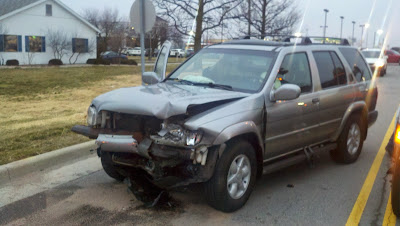Sunday, November 4, 2012
Call Signs
When he was a nugget, his first squadron tagged him with the call sign “Magua.” He earned this name not through prowess or by any resemblance to a warrior from The Last of the Mohicans, but rather to the tale of his being cornered drunk by MPs outside a strip club in San Diego and his inability to pronounce his own name: Mark White.
Thirty years later, combat ribbons and the silver star of a Marine
brigadier general sit framed in a small shadow box on his desk in the Oval Office. A different tag now, his detail calls him “Tecumseh.” Shawnee for “panther crossing the sky,” the code name suits a former Hornet driver and sitting war-time president.
Tuesday, October 23, 2012
Grouseland Rifle Connects Our Past and Present
As appearing in "Muzzle Blasts" (October 2012), the official publication of the National Muzzle Loading Rifle Association:
~~~~~~~~~~~~~~~~~~~~~
A sheriff’s deputy stands watch over the 209-year-old muzzle loader, the newly christened State Rifle of Indiana. The Grouseland Rifle, on display at the NMLRA Education Building in Friendship, was crafted around 1803 by Vincennes gunsmith John Small, who among other occupations had been named Indiana’s and Knox County’s first sheriff in 1790. Two centuries later, John Small might be pleased to see a descendant in his line, lean and tough and wearing the modern badge of a Knox County Sheriff, standing guard over one of the few remaining firearms that Small had crafted.
William Small wrote that his father stood 6’1” and weighed precisely 184 pounds, which was not unlike the stature of the young deputy now on over-watch. For a moment, time seems compressed and it doesn’t take much to imagine the presence of John Small’s spirit.
Saturday, September 15, 2012
How Did You Get Here So Fast?

Her head was pitched back against the driver’s headrest, her jaw slack as the Lexus SUV idled through the intersection. If Jill and I could have seen her eyes, we’d have seen only the whites. No hands appeared on the steering wheel.
“Holy shit,” I said, leaning forward to the windshield. “I think that driver’s unconscious.”
Labels:
Epilepsy
Saturday, September 1, 2012
A Boy on Sargent Road
Friday’s rush-hour traffic has me looking for a path of
least resistance. I exit the interstate in favor of side roads. Driving home
toward Fishers, I turn onto Sargent Road -- a shaded route that lazes its way
northeast through Marion County.
Settlers first entered the Mud Creek Valley here in 1824. The farmhouse with chipped white paint and a latticed porch still stands where Johnny Sargent's father built it in the 1880s.
Across the road and obscured by overgrowth, a sagging barn guards the entrance to the
fallow field where Johnny flew in and out with his J-3 Piper Cub in the
mid-1950s.
Monday, June 11, 2012
Muzzle Loaders and Biker Bars
Jeff probably has writer’s cramp from signing twenty copies
of his book, John Small of
Vincennes: Gunsmith on the Western
Frontier (http://www.redaviscompany.com/1242.html). Writer’s cramp is also called “scrivener’s palsy.” But scrivener’s palsy sounds nasty and incurable and medieval, and not something you can relieve by flapping your hands at the wrist. We’ll just call it writer’s cramp.
We’ve left the grounds of the National Muzzle Loading Rifle
Association in southeastern Indiana, where Jeff has spent the day answering
questions and autographing books for visitors who’ve come to see the Grouseland
Rifle. This newly named State Rifle of
Indiana was crafted by gunsmith
John Small sometime around 1803.
Small was Indiana’s first sheriff, a colonel in the
territorial militia, and a master craftsman who made long rifles, pistols, and
tomahawks for many of the great figures of the period, including George Rogers
Clark, Meriwether Lewis, and William Clark.
His Indian name was “Big Knife.” John Small was pretty much a pioneer action hero.
His Indian name was “Big Knife.” John Small was pretty much a pioneer action hero.
Monday, February 13, 2012
Pathfinder as Destrier
A Fishers patrol car blocked the road at 131st Street. I pulled alongside and the officer leaned out his window. I pointed to the accident scene -- a head-on collision.
“One of the drivers,” I choked it out. “My wife...”
He softened and gestured to a second cruiser. “She’s in the back of that one.”
The passenger door opened and Jill climbed out. I put my hands on her shoulders and looked in her eyes. She was scared, but uninjured. I looked past her to the Pathfinder she’d been driving.
.jpg) The front end was mangled. Airbags hung from the dash like deflated lungs. A seat belt draped out the driver’s side door like a protective arm now dangling limp toward the pavement. Our truck was bleeding fluid onto the street. It was dying.
The front end was mangled. Airbags hung from the dash like deflated lungs. A seat belt draped out the driver’s side door like a protective arm now dangling limp toward the pavement. Our truck was bleeding fluid onto the street. It was dying.
“One of the drivers,” I choked it out. “My wife...”
He softened and gestured to a second cruiser. “She’s in the back of that one.”
The passenger door opened and Jill climbed out. I put my hands on her shoulders and looked in her eyes. She was scared, but uninjured. I looked past her to the Pathfinder she’d been driving.
.jpg) The front end was mangled. Airbags hung from the dash like deflated lungs. A seat belt draped out the driver’s side door like a protective arm now dangling limp toward the pavement. Our truck was bleeding fluid onto the street. It was dying.
The front end was mangled. Airbags hung from the dash like deflated lungs. A seat belt draped out the driver’s side door like a protective arm now dangling limp toward the pavement. Our truck was bleeding fluid onto the street. It was dying.
Subscribe to:
Posts (Atom)

